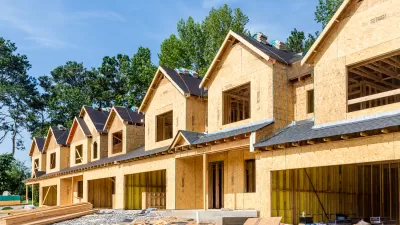James Howard Kunstler attends the annual meeting of the Association for the Study of Peak Oil and Gas (ASPO) and finds downtown Houston a "ghastly" environment that shows that even without zoning a city can achieve "miserable" results.
"The big Peak Oil conference of the year took place in Houston last week – but before we get to the substance of that, a few words about where we were. It is hard to imagine a more horrifying urban construct than this anti-city in the malarial swamps just off the Gulf of Mexico. And it is hard to conceive of a more desolate and depressing urban district, even of such an anti-city, than the utter wasteland around Houston's convention center.
Luckily, we didn't have to enter the convention center itself across the street -- a baleful megastructure the size of three aircraft carriers, adorned with massive air-conditioning ducts to counter Houston's gym-sock-like climate. And when I say "street" you understand we are talking about four or six-laners, with no curbside parking, which is the norm for this town. The effect is that every street behaves like an extension of the freeway at the expense of pedestrians – but pedestrians have been eliminated anyway because in ninety percent of Houston's so-called downtown of glass towers there are no shops or restaurants at the ground-floor level, only blank walls, air-conditioning vents, parking ramps, and landscaping fantasias. We were informed that in parts of downtown there existed a network of air-conditioned underground corridors with shopping, but that everything in it closed at 7 p.m. when the last office workers straggled home. Anyway, none of it extended as far as the convention center. The rest of district was devoted to surface parking.
It has often been stated that Houston's ghastly development pattern comes from having no official zoning laws. But all it really proves is that you can achieve the same miserable results of typical American boneheaded zoning with no zoning – as long as your don't give a shit how people feel in their daily environments.
The convention center itself, though, demonstrated something beyond even that degree of thoughtlessness. Its pharaonic hugeness was a metaphor for the fatal grandiosity at the heart of contemporary life in American today, the utter disregard for a scale of human activity consistent with what the planet has to offer within its ecological limits – and of course the oil issue was at the center of that story."
FULL STORY: Peak universe

Pennsylvania Mall Conversion Bill Passes House
If passed, the bill would promote the adaptive reuse of defunct commercial buildings.

Planning for Accessibility: Proximity is More Important than Mobility
Accessibility-based planning minimizes the distance that people must travel to reach desired services and activities. Measured this way, increased density can provide more total benefits than increased speeds.

Fair Housing Cannot Take a Back Seat to ‘Build, Baby, Build’
If we overlook fair housing principles in the plan to build US housing back better, we risk ending up right back where we started.

LA Metro Board Approves New 710 Freeway Plan
The newest plan for the 710 corridor claims it will not displace any residents.

Austin’s Proposed EV Charging Rules Regulate Station Locations, Size
City planners say the new rules would ensure an efficient distribution of charging infrastructure across the city and prevent an overconcentration in residential areas.

Making California State Parks More Climate-Resilient
A recently released report offers recommendations for keeping state parks healthy and robust, including acquiring additional land for conservation and recreation.
City of Costa Mesa
Licking County
Barrett Planning Group LLC
HUD's Office of Policy Development and Research
Mpact Transit + Community
HUD's Office of Policy Development and Research
Tufts University, Department of Urban and Environmental Policy & Planning
City of Universal City TX
ULI Northwest Arkansas
Urban Design for Planners 1: Software Tools
This six-course series explores essential urban design concepts using open source software and equips planners with the tools they need to participate fully in the urban design process.
Planning for Universal Design
Learn the tools for implementing Universal Design in planning regulations.























